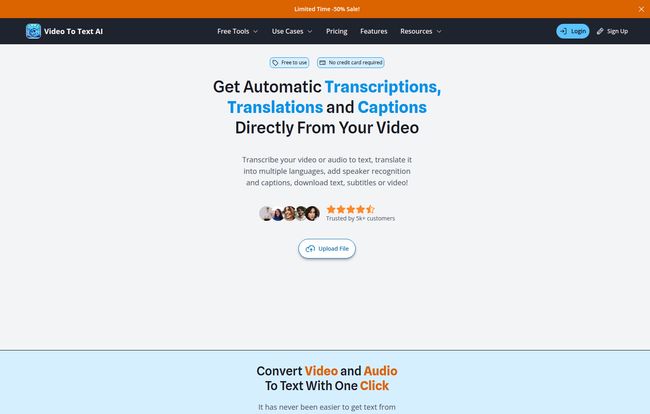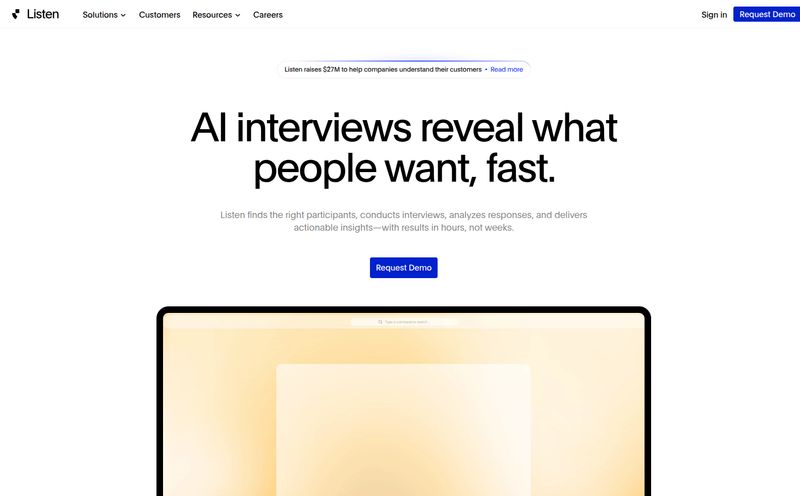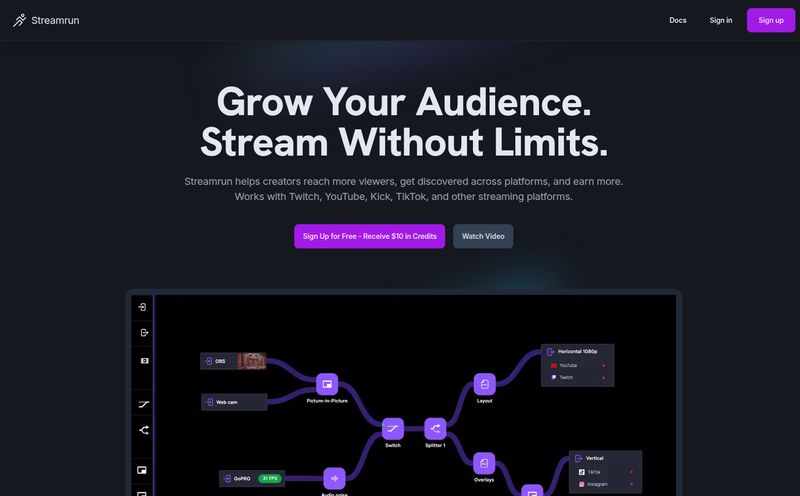If you’re in the content game—whether you're a podcaster, a YouTuber, or an SEO like me who’s constantly trying to squeeze more juice out of every piece of content—you know the grind. And one of the biggest, most soul-crushing grinds has always been transcription. I can't even count the hours I've lost, headphones clamped on, hitting rewind every ten seconds to catch that one mumbled word. It’s the digital equivalent of washing a mountain of dishes by hand. Tedious. Time-consuming. And frankly, I'd rather be doing literally anything else.
So, like everyone else, I’ve been watching the rise of AI tools with a mix of excitement and skepticism. We've all seen them. Promises to change our lives, automate everything, and probably make us a sandwich. A while back, I stumbled upon a platform called Video To Text AI, and the name alone was direct enough to get my attention. No fluff. It does what it says on the tin. But the real question is, does it do it well? I’ve been kicking the tires on it for a while now, and it's time to share my thoughts.
So, What Is Video To Text AI Anyway?
In simple terms, Video To Text AI is a tool that takes your video or audio files and automatically spits out a written transcript. But that's just the starting point. It also translates that text, helps you create perfectly timed subtitles for your videos, and even has a clever AI chat function to help you analyze the content. Think of it as a Swiss Army knife for your spoken-word content. You feed it a video of a webinar, a podcast interview, or even a short social clip, and it gives you back a treasure trove of written material to work with. The whole idea is to stop letting your valuable audio and video content die after one use.
Putting It to the Test: The Core Features
A tool is only as good as what it can actually do. So I ran a few of my own projects through it – a recent client podcast, a short video for social media, and an old webinar recording that was just gathering digital dust. Here’s how it stacked up.
The Transcription Engine: How Accurate Is It Really?
This is the make-or-break feature, right? If the transcription is garbage, nothing else matters. I uploaded a 15-minute audio file with two speakers. The audio quality was pretty good, and the accents were fairly neutral. The result? I was genuinely impressed. I'd say it was about 95-98% accurate. There were a few minor mistakes, mostly with niche jargon or proper nouns, which is to be expected from any AI. The punctuation was also surprisingly good, which is a huge timesaver.
Now, I also threw it a curveball: a video with some background noise and a speaker with a thicker accent. As expected, the accuracy dipped a bit. It’s not magic. The old rule of “garbage in, garbage out” still applies. But for clean audio, it’s more than capable. The editing interface is straightforward, letting you easily click and correct any little errors, which you're going to have to do with any AI transcription service.
Beyond Just Words: Translation and Subtitles
This is where things get interesting for expanding your reach. The platform claims to translate into over 100 different languages. I tested the English-to-Spanish translation on a short script, and my Spanish-speaking colleague said it was “surprisingly not terrible.” High praise, believe me. It’s likely a machine translation, so for critical work, you’d want a human to review it, but for making your content accessible to a wider audience with subtitles? It's fantastic.
Speaking of subtitles, it generates those industry-standard SRT or VTT files that you can upload directly to YouTube, Vimeo, or social platforms. This is huge for both video SEO and accessibility. More people watch videos with the sound off than you'd think, especially on mobile. Not having captions is like leaving engagement on the table.

Visit VideoToTextAI
The "AI Chat" Feature: Gimmick or Game-Changer?
Okay, I'll admit, when I saw “Chat with AI,” I rolled my eyes a little. It sounded like a gimmick. I was wrong. This feature is probably my favorite part of the whole platform. After you get your transcript, you can open a chat window and literally talk to your document. I asked it to “summarize this conversation in five bullet points,” and it did. I asked, “What were the main points made about traffic generation?” and it pulled them right out. I even said, “Find me a good quote about the future of SEO,” and boom, there it was, with the timestamp.
This isn't just a novelty. It's like having a research assistant who has already watched the entire video for you. For content repurposing, it’s a goldmine. You can instantly pull out key takeaways for a Twitter thread, find quotable moments for social graphics, or get a high-level summary to start writing a blog post. It turns a one-hour webinar into a dozen different content ideas in minutes. A real game-changer.
The All-Important Question: The Pricing
Alright, let's talk money. We all love a powerful tool, but not if it breaks the bank. Video To Text AI has a pretty simple pricing structure, which I appreciate.
First, there's a Free plan. You get 60 credits per month, which they say is about 3 minutes of rendering. It's not a lot, but it's more than enough to test the platform and see if it works for your specific needs. You can transcribe, translate, and use the AI chat. The main limitations are the short file duration (up to 10 minutes), a watermark on video exports, and your files expire after 10 days. It's a solid free trial, not a long-term solution for creators.
Then there’s the Pro plan, which is currently $9.99 per month. This jumps you up to 1200 credits a month (about an hour of rendering) and unlocks everything. You can upload longer files (up to 2 hours), there's no watermark, and you get access to more advanced features like Speaker Recognition, which is critical for interview-style content. For less than the cost of a couple of fancy coffees, you get a tool that can save you hours of work every month. In my opinion, if you produce video or audio content even semi-regularly, the Pro plan is a no-brainer.
| Feature | Free Plan | Pro Plan ($9.99/mo) |
|---|---|---|
| Monthly Credits | 60 | 1200 |
| Max Upload Duration | 10 minutes | 2 hours |
| Speaker Recognition | No | Yes |
| Watermark on Video | Yes | No |
Who Is This Tool Actually For?
I can see a few groups getting a ton of value from this.
- Podcasters: Turn your episodes into full blog posts, create detailed show notes in seconds, and pull out dozens of social media clips. The speaker recognition on teh Pro plan is a must.
- YouTubers & Video Creators: Generate accurate captions and subtitles to boost accessibility and watch time. Translate them to reach a global audience. Use the transcript as a base for a companion blog post to improve your site's SEO.
- Marketers: That hour-long webinar you hosted? It’s not one piece of content anymore. It’s a blog post, 10 tweets, a LinkedIn article, and an email newsletter. The AI Chat feature makes this kind of content repurposing ridiculously fast.
- Students & Researchers: Transcribe lectures or interviews so you can search and reference them easily instead of scrubbing through hours of audio.
My Final Verdict: Is Video To Text AI Worth Your Time?
So, we come back to the original question. Is it any good? Yes, it is. It's a surprisingly powerful and well-thought-out tool that solves a very real, very annoying problem for content creators. It's fast, reasonably accurate, and the AI Chat feature is legitimately a killer app that sets it apart from many basic transcription services.
It's not perfect. You’ll still need to do a quick proofread, and its performance depends heavily on your audio quality. But it takes a task that used to take me hours and reduces it to minutes. That's a massive win. For the price, especially the $9.99 Pro plan, the return on investment in terms of time saved is huge. It has earned a permanent spot in my content creation toolkit.
Frequently Asked Questions
Is Video To Text AI completely free?
It has a free plan that gives you 60 credits monthly, which is enough to try out the features on short files. For regular use, you'll likely want the Pro plan which has more credits and features.
How accurate is the transcription?
It's very accurate with clear audio, often reaching 95% accuracy or higher. However, accuracy will decrease with heavy background noise, multiple people speaking over each other, or strong accents.
Can I transcribe a YouTube video directly?
Yes, one of the best features is that you don't have to download the YouTube video first. You can just paste the YouTube URL directly into the tool, and it will pull the audio and transcribe it for you.
What's the main difference between the Free and Pro plans?
The biggest differences are the number of credits (60 vs. 1200), the max file length, and the Pro features. The Pro plan includes speaker recognition (labeling who is speaking), has no watermark on video exports, and offers priority support.
What is the AI Chat really for?
It's for analyzing your transcript. You can ask it to summarize the text, pull out key topics, find quotes, or even ask specific questions about the content of the video, saving you from having to re-read or re-watch the whole thing.
Reference and Sources
- Video To Text AI Official Website: https://www.videototextai.com/
- Video To Text AI Pricing Page: https://www.videototextai.com/pricing
- Search Engine Journal - A Beginner’s Guide to Video SEO: https://www.searchenginejournal.com/video-seo-beginners-guide/444926/
- HubSpot - How to Repurpose Content: https://blog.hubspot.com/marketing/content-repurposing



